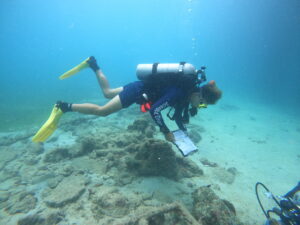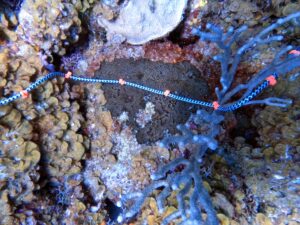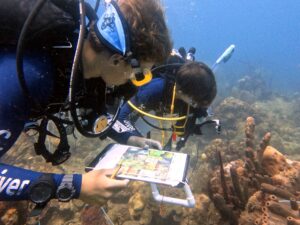During the 2024 St Croix summer trip we did a handful of fish surveys and benthic dives. We did these dives to collect data for our science projects and to input it into the REEF database. To do our fish and benthic dives we all had to wake up between 6-8 in the morning and we left between 7-9. The times would change depending on what dive site we were going to.

Connor practices his underwater positioning and trim during a fish survey at the Frederiksted Pier in St Croix.
Once we got to the dive site we would all take our dive gear and science gear out of the truck and set both of them up for our dive. Setting up our dive gear would include putting our BCs on our tanks and doing a pre-dive safety check. Setting up our science gear would be getting our data sheets on a clipboard and if needed our transects. Once they were set up we would get in the water, either walk in if it was a shore dive or giant stride in if the dive was off a boat or pier.
Data Collection Underwater

A sample transect line across algae, gorgonians, and other benthic invertebrates. Divers record what is under each ziptie every 10cm.
When under the water we would conduct our surveys. The way the fish survey is done is we would swim around and mark in a data sheet what fish there were and an estimate on how many of those species we saw. The benthic survey was done by placing a weighted rope with measurements 10 centimeters apart, also known as a transect line, along a coral reef on the ocean floor in a straight line. To get accurate data the line is also loose so it matches the rugosity of the bottom floor. Then we would swim and mark what benthic organism is underneath each point.
After conducting those dives we would get into our science groups back at camp and put our data into our bigger data sheets on our computers. One thing we discovered with the benthic dives is that there is much less live coral in the reefs of St. Croix than anybody expected, and mostly because of disease and bleaching. On a couple of the wall dives we did there was a group of Caribbean reef sharks that were swimming with us during the first dive and on the second wall dive after that the same group of sharks joined us again for our dive. Also, on all the dives done at the pier, there were many sea turtles that were either eating or just swimming by.
Precision of Science Diving
I enjoy both benthic and fish survey dives just as much as the other. I perfected on keeping good trim and buoyancy doing these dives and better learned how to identify different fish and benthic organisms. Something that was difficult was not hitting anything, especially coral when doing the benthic surveys and keeping under a certain depth on any wall dives. Even though we had to wake up a little early to do the fish and benthic survey dives, they were all a really fun experience, especially since they were on the island of St. Croix.
— Connor S., Second Class Naut, Tarpon Springs


